Ashwagandha Cultivation Guide:
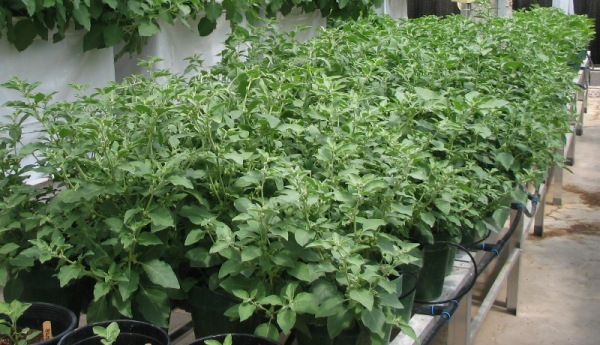
Introduction of Ashwagandha:
Ashwagandha or Asgand is an erect growing, branching shrub with a normal height of 1.4 to 1.5 meters. This plant grows well in dry and sub-tropical regions. Ashwagandha is a hardy and drought tolerant plant. Ashwagandha is also known as “Indian ginseng” or “poison gooseberry” or “winter cherry “and it is a native medicinal plant grown all over north-western and central parts of India. Ashwagandha herb is an important ancient plant whose roots have been used in Indian traditional systems of medicine such as ayurveda and unani. Ashwagandha herb belongs to the family of “Solanaceae” and genus of “Withania” and its scientific name is “Withania somnifera”. Ashwagandha leaves are dull green, elliptic, usually up to 10 to 12 cm. long. Usually, the flowers are small, green and bell-shaped. The ripe fruit is usually an orange-red color. Commercial cultivation of Ashwagandha will have decent profits provided there are good farm management practices in place and proper marketing model built. Parts used are plant root and leaf seed.
Common names of Ashwagandha:
Asgandh, Nagouri Asgandh, Punir, Winter cherry, poison gooseberry, and Indian ginseng.
Health Benefits of Ashwagandha:
The following are some of the health benefits of Ashwagandha.
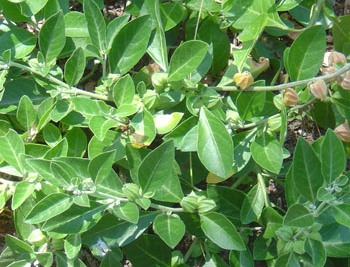
- Ashwagandha boosts the immune system.
- Ashwagandha helps in lowering cholesterol.
- Ashwagandha helps in regulating blood Sugar levels.
- Ashwagandha is good for the heart.
- Ashwagandha stimulates collagen & promotes wound healing.
- Ashwagandha reduces depression, stress & anxiety.
- Ashwagandha stimulates underactive thyroid.
- Ashwagandha increases muscle mass & strength.
- Ashwagandha helps in reducing swelling & pain.
- Ashwagandha boosts memory and cognitive performance.
- Ashwagandha benefits a healthy reproductive system in both males & females.
- Ashwagandha boosts energy levels and vitality.
- Ashwagandha is good for joints and eye health.
- Ashwagandha prevents some sort of cancer cells growth.
The Major Production States of Ashwagandha in India:
Madhya Pradesh, Gujarat, Haryana, Maharashtra, Punjab, Rajasthan, and Uttar Pradesh are the main producing states of this crop in India.
Local Names of Ashwagandha in India:
Ashgandh, Asgandh , Ajagandha, Nagouri Asgandh, rasbhari (Hindi), Amukkara, Amukira, Asuragandi (Tamil), Amukkuram, Trittavu, Ayamodakam (Malayalam), Dhuppa (Bengali), Keramaddinagaddi , Kanchuki (Kannada), Askandha, Dorgunj , Ghoda , Tilli (Marathi), Asod, Ghoda ahan, Ghoda akan, Asun , Asam, Ghodasoda (Gujarati), Penneru, Vajigandha (Telugu).
You may also check Growing Triphala.
Varieties of Ashwagandha:
Jawahar which is short in stature and most amenable for high-density planting. The variety yields in 6 months with a total withanolide content of 0.30 percent in dry roots.
Climate Required for Growing Ashwagandha:
Ashwagandha crop can be grown from sea level to an altitude of 1500 meter above sea level. The semi-tropical regions which receive about 500 to 800 mm annual rainfall are best suited for its cultivation. This crop requires dry season during its growing period and temperature between 20°C to 38°C is most suitable for cultivation. This crop even tolerates temperatures as low as 10°C.
Soil Requirement for Ashwagandha Plantation:
Ashwagandha crop can be grown well in sandy loam or light red soil with good drainage having a pH value of 7.5 to 8.0.
Land Preparation for Ashwagandha Plantation:
The soil of the field selected for Ashwagandha cultivation is well pulverized by plowing or harrowing. Two to three ploughings should be given to bring the soil to fine tilth stage and this should be done before the rainy season. Supplementing with well-decomposed farmyard manure (FMY) is beneficial in getting a good yield of the crop. Ashwagandha is usually grown in fields which are not well covered by the irrigation systems.
Propagation, Nursery Raising & Planting in Ashwagandha Cultivation:
Ashwagandha crop is propagated through seeds. Disease-free and high-quality seeds should be selected and sown in well-prepared nursery beds. Although it can be sown directly by the broadcast method in the main field, transplanting method is preferred for better quality so that they will be the best suit for export. For export quality, a well-maintained nursery is a prerequisite. The nursery bed, usually raised from ground level should be prepared by thorough mixing with garden compost and sand. About 5 kg of seeds should be required for planting in one hectare land of the main field. The nursery should be raised in the month of June and July. Seeds should be sown just before the onset of monsoon and covered thinly using sand. Generally, the seeds germinate in six to seven days. About 35 to 40-day old seedlings can be transplanted in the main field.
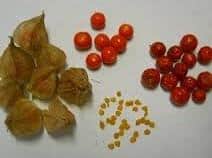
Transplanting of Ashwagandha:
After the manure is supplemented in the soil, ridges should be prepared at 50 to 60 cm spacing. Healthy seedlings of 35 to 40 days old should be planted at 30 cm distance. A spacing of 60 cm x 30 cm with a plant population of about 55,000 seedlings per one hectare is considered as optimum density.
Seed Treatment in Ashwagandha Cultivation:
As the seedlings are prone to seed-borne diseases, the seeds must be treated before sowing in the nursery beds or field. Seeds should be treated with Thiram @ 3 grams/kg seed.
The Seed Rate and Sowing Method of Ashwagandha:
Usually, this crop requires a seed rate of 12 kg per ha is sufficient if you chose to go for the broadcasting method. The line to line method is best suited as it increases root yield and helps in performing intercultural operations easily. The seeds should be sown about 1cm to 3 cm deep. Seeds should be covered with light soil in both methods. The line to line distance of 20 cm to 25 cm and plant to plant distance of 8 cm to 10 cm should be maintained. The spacing of plants usually depends on soil fertility and cultivar (variety).
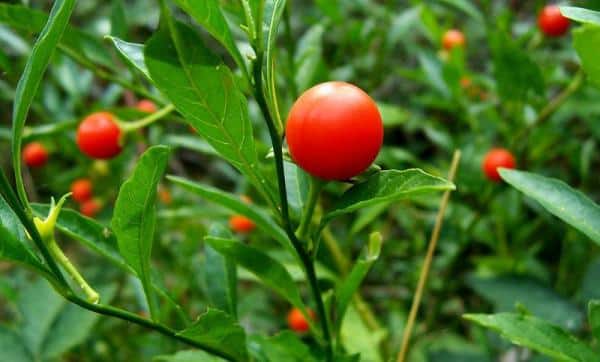
Manures and Fertilizers of Ashwagandha Crop:
Ashwagandha crop responds very well to Farm Yard Manure (FYM), Vermicompost, and Green Manure. Usually, this crop demands 10 to 12 tonnes of well-decomposed farmyard manure (FMY) or 1 to 1.5 tonnes Vermicompost per 1-hectare plantation. If the soil has average fertility, supplementing with 15 kg of ‘N’ and 15 kg of ‘P’ per ha field is beneficial for getting a higher yield. In the case of poor fertility soils, it is recommended to apply 40kg of ‘N’ and 40 kg of ‘P’ per hectare for high root yield.
Water requirement of Ashwagandha Plants:
Ashwagandha crop does not tolerate excessive irrigation or waterlogging conditions. Providing light irrigation at the time of transplanting ensures the better establishment of seedlings in the soil. For better root yield, irrigate the crop once in 8 to 10 days interval.
Weed Control in Ashwagandha Crop:
The seeds were sown by broadcasting method or in the line method in furrows should be thinned out by hand at 30 days after sowing to maintain a plant population of about 30 to 60 Ashwagandha plants per square meter. The plant density to be used may depend on the nature and fertility of the soil. One hand weeding at an early stage is sufficient to enable the Ashwagandha plants to take over the growth of weed which gets suppressed by its smothering effect. Generally, 2 weedings should be required to keep weeds away, the first weeding should be carried out within 21-25 days of sowing and the second should be carried after 21-25 days of first weeding.
Pests and Diseases of Ashwagandha Crop:
The common pests and diseases found in Ashwagandha cultivation are aphids, mites and insect attack, seedling rot, and blight. However, there are no serious pests found in this crop. Selecting disease-free seeds and treating seeds before sown is essential to reduce these incidents. To prevent diseases, bio-pesticides could be prepared from Neem, Chitrakmool, Dhatura, Cow’s urine, etc. Apart from these, adopting crop rotation and having proper soil drainage will reduce the impact of any diseases.
When and How to Harvest Ashwagandha:
Drying leaves and red-orange berries indicate the maturity and harvest time. Ashwagandha crop will be ready for harvesting 160-180 days after sowing. The whole plant should be uprooted for roots, which are then separated from the aerial parts by cutting the stem 1 to 2 cm above the crown. They should be then cut into small pieces of 8 to 10 cm to facilitate drying.
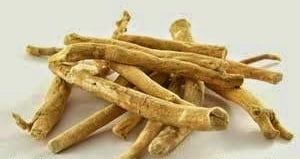
The Yield of Ashwagandha:
The yield of the crop depends on many factors like soil fertility, irrigation, and farm management practices. An average yield of about 450 to 500 kg of roots and 50 kg of seeds can be obtained from one-hectare land.
Marketing of Ashwagandha:
The Neemuch and Mandsaur markets of Madhya Pradesh are the popular world over for Ashwagandha. Importers, buyers within the country, processors, traditional practitioners, Ayurvedic, and Siddha Drug manufacturers visit these markets for procurement of Ashwagandha roots every year. Before going on a large scale, establish or find out marketing for the crop. Contacting any herbal/ayurvedic companies would be the best choice. The sale price of dried roots and seeds has been considered at Rs.90/kg and Rs.75/kg respectively.
Economics of Ashwagandha Cultivation:
The following is a rough estimate of cost and profit details.
Roughly it cost s Rs.5,600 per 1-hectare plantation (provided you own the land)
Return from 1 hectare plantation is about :Rs.30,000.
Approximate net income is about: Rs.24,000.
Note: The above cost is not constant and may depend on current market labor/cost of the material used in the crop.
You may be interested in Growing Oregano.
Is ashwagandha can be grown under shade trees like sandalwood and teak ?
Read the complete article to understand the plant characteristics.
i would like to know about Ashwagndha crops cultivation and from where seeds will be available.